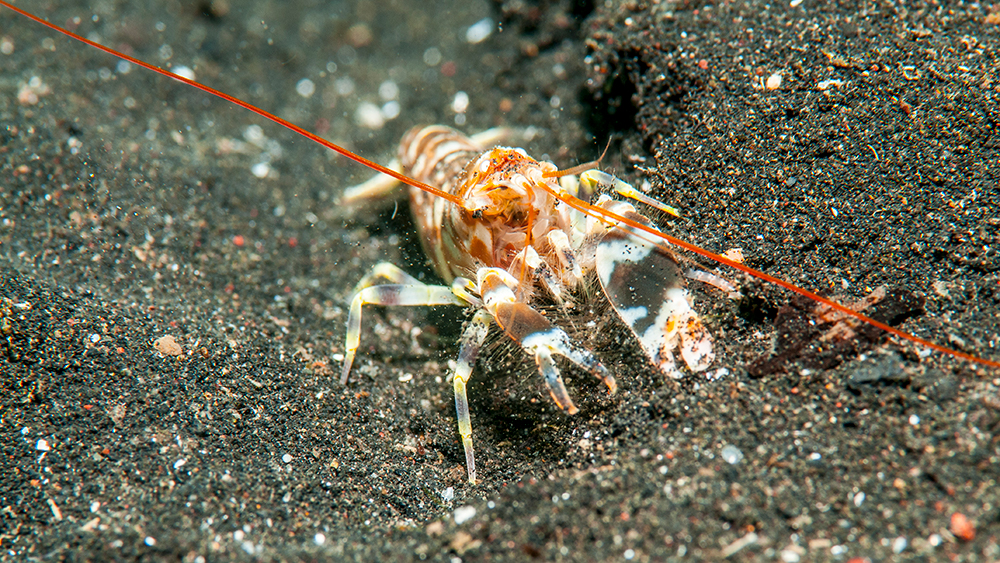
Texas A&M University researchers are looking to nature for inspiration in developing a new method of underwater plasma generation using shrimp as a model — a discovery that could provide significant improvements for actions ranging from water sterilization to drilling.
Dr. David Staack, associate professor in the J. Mike Walker '66 Department of Mechanical Engineering, and Xin Tang, a Ph.D. candidate and graduate research assistant in the department, used 3D printing technology to replicate not only the physical shape of a snapping shrimp's claw, but also the complex mechanism through which it generates plasma.
The team’s research was published on March 15 in the online journal Science Advances.
"Generally, when you look to nature, evolutionary pressure makes it so that nature is very efficient at doing things," Staack said. "I find it interesting that the shrimp has been doing intense shock waves, plasma chemistry and nanoparticle synthesis for millions of years."
When the snapping shrimp — also known as the pistol shrimp — snaps its claw, it shoots out a jet of water fast enough to generate a bubble that, when it collapses, creates a loud noise and emits light. The high pressures and temperatures produced in this process lead to plasma formation.
The project, led by Staack, began more than four years ago as an offshoot of a National Science Foundation (NSF)-funded project on electrical discharge plasma in liquids. In comparing the plasma-generation process of the snapping shrimp to their electrical plasma process, the researchers became curious if they could find a way to measure and replicate its properties.
The researchers set out to mimic the mechanics of the snapping shrimp's claw with initial support from the NSF, carefully studying how the sea creature creates a cavitation bubble that generates plasma at upwards of 3,000 degrees Fahrenheit.
"In our paper, we report the first direct imaging of the light emission induced by the same method the shrimp uses: the mechanically generated energy focusing on

Previous attempts at replicating the shrimp's behavior focused on the two-dimensional geometry of the shrimp, ultimately missing some of the complex 3D processes that newer technology allowed the researchers to recreate the mechanism successfully.
Staack and Tang created a 3D model of a snapping shrimp's molted claw husk five-times larger than it appears in nature. To power the mechanism without the aid of the shrimp's muscles, the researchers implemented a mousetrap-like spring system.
In nature, shrimp use the cavitation bubble as a weapon to generate shocks and stun their prey. A scaled-up version of the shrimp's mechanism could be used for a broad range of disciplines including analytical chemistry, physics
"Shrimp use the systems as a weapon and that is certainly one application," Staack said. "The pressure and shocks can stun small fish or break-up a kidney stone. The cavitation and dynamics can be used to modify boundary layer flow and reduce drag for a boat. Other applications take advantage of the chemistry of the plasma state. Nanoparticles can be synthesized with exotic phases due to the extreme conditions during synthesis. Water can be sterilized. Oil can be upgraded."
Drawing inspiration from the snapping shrimp’s plasma and shockwave capabilities, Staack is working with a team of colleagues from the mechanical engineering department on a spin-off project to advance the drilling technology used to create geothermal wells that tap into the Earth’s natural heat. By enabling electrodes on the tip of a drill bit to emit a microscopic plasma discharge, the technology will help break through hard rock and streamline the drilling process.
Moving forward, Staack said some of the goals for future research include determining the temperature of the plasma generated, finding out how large they can scale up the mechanism and testing some potential applications.
They are also working on refining the most efficient version of the mechanism, removing parts from the claw model that do not serve a purpose in the creation of plasma.
"What we’ve learned from this is that we don’t need all of this shrimp biology," Staack said. "We need the little back plunger and we need the channel, but we don’t need the part that the shrimp
The bio-inspired snapping shrimp device is relatively easy to build, making it both useful for reproducibility of the science as well as being fun for those interested to explore. Staack believes with appropriate supervision and less than $100, people ages 12 and up could reproduce the device. The materials necessary to reproduce the device have been made available electronically through an open-access platform hosted by the Texas A&M University Libraries.